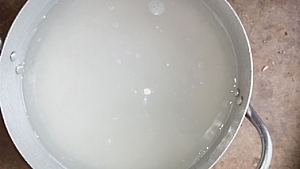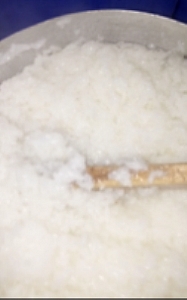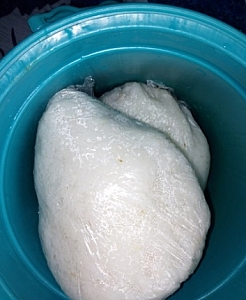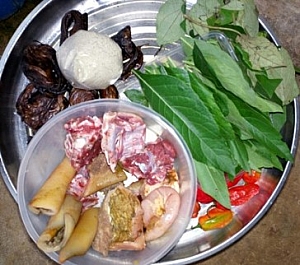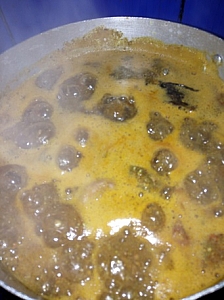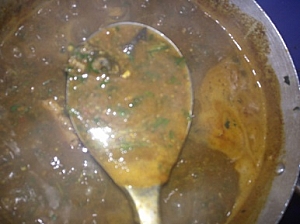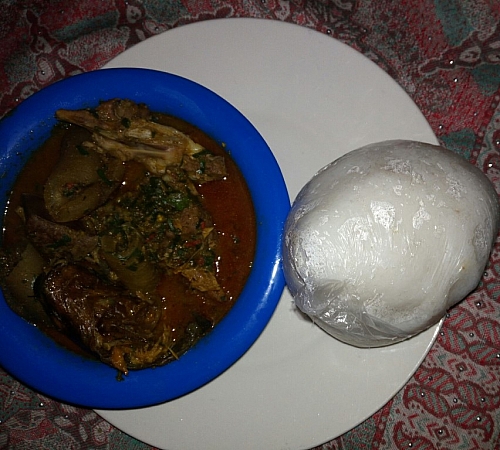
Nigeria is a large country with the population of about 180million with over 350 tribes and cultures. Each of these tribes has its own native dishes prepared from different crops grown in their locality. As divergent as some of these dishes are, they are enjoyed and appreciated by different Nigerians, irrespective of the tribes they are from. There are so many varieties of food in Nigeria such that if we are to start mentioning them according to each tribe, time would not be enough and my writing pad may be exceeded. For this reason, I will just list a few of the foods from the popular tribes which their foods are well known by even to a common Nigerian.
Calabars (Southern part of Nigeria) are known as people who eat:
Edikan-ikong soup– Nigerian popular nutritious vegetable based soup prepared from fluted pumpkin, water leaves, assorted meat, snails, crabs, shrimps and fish among other things.
Afang soup Special blended vegetable based soup prepared from a leaf called Afang with water leaves, snails, periwinkles, assorted meat and fish among other ingredients.
Editan soup– A delicious vegetable based soup made with either okra or water leaves and assorted meat, periwinkles, crayfish and other seasonings.
Ekpang-nkukwuo– A popular delicacy prepared from grated cocoyam and water yam usually wrapped with leaves and cooked into pottage.
Atama soup– Another spicy vegetable base soup made from a special scenting leaf called atama. It is usually made with extracted palm fruit milk called Abak with either egusi or water leaf as the thickener.
Afia efere– Popularly known as Calabar white soup, thickened with pounded yam and spiced with uyayak (Aiden fruit, it is usually prepared without palm oil and eaten with pounded yam.
Fufu– A starchy bolus made from grated processed cassava used for eating the above soups.
The Yorubas (Western part of Nigeria) are known for eating more of:
Beans porridge-A porridge made from either brown or white beans with palm oil and seasonings
Moi-moi– A cake-like food made from grinded beans. fish/ eggs and seasonings used as fillings
Ewedu soup– A viscous soup made from a greenish vegetable called ewedu mostly eaten with stew and amala.
Efo riro– A popular Yoruba soup made with spinach, locust beans (dawadaw), red bell pepper and palm oil.
Yam porridge-This is a sweet red pottage prepared with yam, palm oil seasonings and vegetables.
Beans soup– A native soup prepared from grinded bean and meat and other seasonings
Pounded yam (iyan) – This is a soft smooth dough gotten from mashed yam. It is usually eaten with any rich kind of vegetable soup including ewedu.
The Igbos are also known for eating
Egusi soup– A yellowish soup made from melon seed with or without vegetables and palm oil.
Oha/Ora soup– A vegetable bases soup made from plant called Oha tree – with smashed cocoyam or ofor or achi among other things.
Ogbono and okro soup– A viscous soup made from lady fingers and another viscous seeds known as African bush mango.
Ofe onugbo– A bitter leafsoup prepared from bitter vegetables after the bitter taste has been washed out. It is usually combined with egusi (groundmelon or mashed cocoyam. Seehow to wash bitter leaf here
Abacha African salad made from shredded cassava with oil bean seed after fermentation, palm oil, garden eggs and vegetables.
Isi ewu– This is also called goat head pepper soup made from goats head with edible pattash, palm oil and herbs.
Banga stew/soup– A yellow palm kernel stew prepared from extracted palm fruit milk with scent leaves, usually eaten with boiled white rice. the palm fruit extract is used for cooking Banga soup is different from the regular palm oil we use for cooking other soup. It is the mixture of oil and water obtained by cooking and pounding the fruits before filtering it.
Akpu– A staple food made from processed cassava
The Hausas (Northern part of Nigeria) are known for:
The Northern part of Nigeria is blessed with a lot of food crops, almost all the foods consumed in Nigeria are imported from the North, you mention food, crops, fruits and live-stocks like:
Irish and sweet potatoes, yams, tomatoes, carrots, cucumbers, green beans and peas, onions, peppers, corns, guinea corns, groundnuts, beans, okra, cabbages, green peppers, garden eggs, water melons goats, cows, horse, sheep, just to mention a few. The following are the common food found among the Hausas.
Miyan kuka– A native soup prepared from a grinded dried baobab leaves with dry Okro. It is eaten with alebo (cassava flour), tuwa masara (corn four).
Miyan wake– Beans soup- is a soup prepared from mashed beans, it is enriched with fish, meat, palm oil among other things.
Miyan taushe– a native Northern soup cooked with pumpkin, groundnut butter, and a seasoning known as dawadawa among other things. It is eaten with masa ( rice cake), tuwo shinkafa or tuwo masara.
Miyan karikashi– A delicious and popular greenish-soup loved by the north. It is usually prepared with smoked fish, beef, dawadawa among other things.
Miyan geda (Groundnut soup)– A creamy delicious soup which tastes almost like egusi. Groundnut soup is made from fried, blended groundnut butter.
Tuwo masasra– Corn starch which is made into bolus and can be eaten with any of the above soups
Gote acha Is a dish made of tiny couscous -like grain (Digitaria exilis). It is prepare with a souring tangy taste leaves called yakwa (sorrel) or alehu, biscuit bone and other ingredients
Fura de nono– A raw fermented milk with a slightly thick consistency usually mixed with tiny balls of ground millet
Kunu saki -A popular sweet drink in the north made from millet. It is garnished with pounded dried sweet potatoes, ginger, black, pepper among other spices.
Zobo drink– A non-alcoholic wine-like drink made from a dried Roselle plant flower. It is usually boiled with addition of lemon, ginger after which it is filtered and leaves to cool before adding sugar to it.
Rice masa– A popular rice cake served with miyan taushe as snacks in the North, usually made from grinded rice mixed with sugar, onions, salt and yeast before frying.
And lastly, Tuwo shinkafa (mashed rice, Arborio/Paella rice) A typical northern soft starchy doughy paste made from mashed or soggy cooked rice. It is used for eating the above northern soups. These are just few out of the many dishes we have here in Nigeria. Now back to our main topic of today which is:
Table of Contents
How to Prepare Tuwo Shinkafa and Miyan Busheshen kubewa (dried okro soup)
Tuwo shinkafa is usually made from a white short grain rice grown locally mostly in the north. The reason why this rice is used for making bolus is because it is sticky and contains a lot of starch which cannot be found in the regular long grained white rice we used for making jollof rice or from the short grained brown rice we use for preparing palm oil jollof rice (concoction rice).
Ingredients for preparing tuwo shinkafa
- 3 cup of whit local rice (tuwo rice)
- Transparent nylon to put the mould once done
- A medium cooler to keep it warm
- A wide pot with cover
- Wooden turner
- Enough water to cook the rice till done
How to prepare towu shinkafa
1.Sometimes the rice could contain sand and dirt since it is locally grown, wash the rice with cold water like the way you will do to acha to remove sand and rice backs.
If you are opportune to get the very neat one, just wash it twice into a bowl and leave it to absorb the water for about 5-6 hours or more so that by the time you cook it, it will become soft completely with nograiny chunks to avoid adding water over and over. You can soak it in water over night as some do to achieve a very soft and smooth paste when cooked.
2. After 5 hours pour the rice into a large pot, fill the pot with plenty of water and drop on medium heat to cook till the water dries. Once you keep stirring the rice, it will burn at the bottom of the pot. Allow the water dry gently on it own and check for softness by pressing the rice between your fingers and add more water if needed.
3. When the water starts to dry and rice turns very soft, use a wooden turner to stir as if you are turning semolina till the rice becomes sticky and soggy. Lower the heat a bit and keep stirring till it becomes really starchy such that you can mould with your hands.
4.Add a little water, cover the pot and leave it to steam on a low heat for about 3minutes. The rice will dry and become harden on its own over time, after you pack or fold it into nylon and cover in a cooler.
5.Stir it again with the wooden turner and put off the heat.
How to Mould the Tuwo with a transparent Santana leather (nylon polythene)
6. While the tuwo is still hot, use a plastic saucer or plate to pack the tuwo bit by bit into a transparent Santana nylons to retain it freshness and softness.
7. Make sure that none is left in the pot. You dont leave it in the pot as it will become harden and difficult to fetch when it is cooled. The best time to pack it is when it is still hot because by that time it will be easy to mould to the required shape you want.
8. After packing it, get a medium cooler with a tight cover and pack them inside to enable it remain warm till the time you want to serve them.
Note: Tuwo can be can be preserved or stored in the refrigerator when it remains and later be warmed when needed.
How to prepare Miyan Busheshen kubewa (dried Okro soup)
Miyan busheshen kubewa- Is a viscous soup prepared from roughly chopped sun -dried Okra. This is to say that the Okrawere too hard to follow into the pot of freshly chopped okra which led to sun drying it. The Okra is usually sliced into round shapes, dried under the sun till crispy then pounded or blended with mill or blender before used. The concept of slicing and blending of the Okro implies that there is no room for wastage, some foods can be recycled or reprocessed into something useful.
Miyan Busheshen kubewa (dried okro soup) is usually prepared with smoked fish, ganda( cow hides) and palm oil. Dried Okro soup is popularly known among the Northern Nigerians and some parts of the country like yorubas. What makes this soup special is the fact that it has a nutty taste and a richer flavour more than the well-known fresh green Okra soup, and it usually gets tastier the following day.
Ingredients for preparing miyan busheshen kubewa (dried okra soup)
- 6 teaspoons of grinded okro (Miyan busheshen kubewa)
- kilo Assorted meat- cow hide, liver, towel, intestine and goat meat (kaiyanchiki de Namaa-akuya)
- 2 cooking spoons palm oil (Mai ja)
- A handful uziza leave and bitter leaves
- 5 pieces smoked fish (Busheshen kifi)
- 3 teaspoons grinded crayfish
- 5 Pieces fresh pepper (Burkunu)
- 1 Ball onion (Albasa)
- 2 Pieces caked locust beans (Dawadawa). I used okpei.
- 4 Seasoning cube (Maggi)
- Salt to taste (Gishiri)
Procedure on how to prepare Miyan Busheshen kubewa
1. Wash the assorted meat (kaiyanchiki) severally into a medium size pot and season with cubes, onions, salt and pepper and drop on heat source to cook for 30 minutes. See here for description on how to wash kaiyanchiki. Check to see if the meat is soft.
2. When the meat is soft add 2 cups of water to the pot containing the meat depending on the quantity of soup you want to achieve and cover it to boil.
3. While the pot is on heat, soak the smoked fish in salt water to get rid of sand, de-bone it and keep aside. Pound crayfish together with pepper and keep aside, wash both the uziza and bitter leaves and chop them separately into tiny pieces. You can buy already washed bitter leaves from the market if you have no idea on how to wash it. Step 3 can be prepared ahead of time before embarking on this soup preparation to safe time.
4. Add your pounded crayfish with pepper,mthe remaining seasoning cubes, palm oil, and taste for salt.
5. Add the smoked fish first before adding the dried okro. The okro should be added by spreading and stirring it with a wooden turner in one hand to avoid lumpy consistency floating round your soup. Some people usually remove all the meat from the pot leaving only the stock before adding the dried okro .They add them back after the okra has completely dissolved. You can choose to remove the meat before spreading the okro powder or add it together with the meat and the stock like I did; the two ways are still ok.
6. When you notice the okro completely dissolved and the soup well incorporated (viscous), add the shredded bitter leaves and the uziza leaves and leave it to simmer on a low heat for 3 minutes.
7. Bring the soup off from heat and serve it with tuwo shinkafa.
Note: Some people do add grounded ginger to miyan busheshen kubewa but i doprefer to use uziza leaves instead of ginger based on the following reason;
- Uziza leaf is a nice scenting leaf that gives an irresistible flavour to soups. It adds to the soup a pepper soup-like kind of taste, while the bitter leaf leaves the soup and your mouth with a lasting sweetness after you have finished eating the soup. You can make use of any vegetable of your choice. The soup can still be prepared without vegetables.
- Miyan busheshen kubewa (dried okro soup)gets tastier the following day. You will find this out yourself when you prepare it.
Health benefits of Arborio/Paella rice (tuwo rice)
- Paella rice is an-unpolished and unrefined rice locally grown in Nigeria. It is highly packed with magnesium, zinc, potassium, vitamin BI and B3, B6, calcium, phosphorus, Iron, and fibre.
- It can be used to stop persistence of diarrhoea in infants.
- It can be used for making rice pudding in place of acha pudding.
- Arborio rice helps in digestion process. It helps in healthy bowel movement, thereby helping to prevent constipation.
- It contains a reasonable percentage of fibre in it. Since it contains fibre, it helps to control the amount of calories which one could consume, hence, reducing the chances of over eating.
- The rich fibre content makes it possible for healthy bowel movement and helps to control weight gain since it get one full easily.
- It is packed with high kilogram of magnesium which is able to supply the body with the needed energy especially from Carbohydrate and protein and also keeps the nervous system in good condition.


